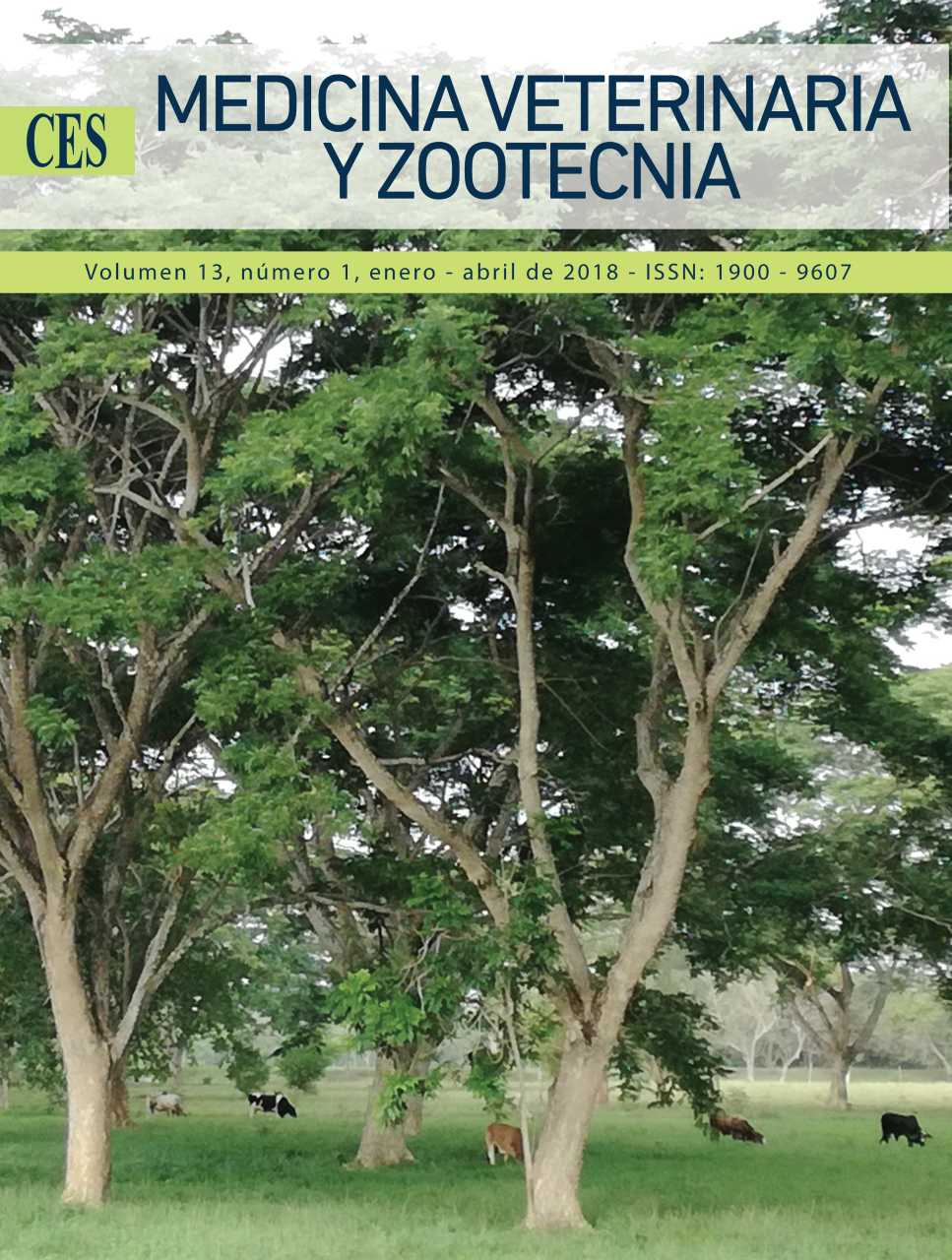Prevalence of gastrointestinal parasites in equines and associated risk factors in several areas of Antioquia, Colombia
DOI:
https://doi.org/10.21615/cesmvz.13.1.1Abstract
There are few reports on the prevalence of gastrointestinal parasites inequines in Colombia. In this study, 946 horses were sampled from a totalof 204 farms in the municipalities of Rionegro and those that comprisethe Valle de Aburrá, in the department of Antioquia. Fecal samples weretaken directly from the rectum and processed by the McMaster, Baermannand Graham techniques. The prevalence of parasites at the farm level was56.3% for Strongylidae, 10.7% for Strongyloides spp, 2.8% for Oxyuridae and0.3% for Dictyocaulus spp. From a practical point of view, the most pathogenicparasites and of greatest resistance concern were the Cyathostomids,which are included within the Strongylidae and whose prevalence was greaterthan 50%. The OR of presenting Strongylidae was 49% lower in equinesthat participated in fairs compared to those that did not. The OR of presentingStrongylidae was 56% lower in equines that use stables than those notbeing stalled. Also, the OR of being positive to Oxyuris equi was 88% lowerin animals that participate in fairs compared to those that did not, and was3.66 times higher in equines with body condition ≤ 2 in comparison withthose of body condition ≥3. Based on this information, it is important toinitiate studies that evaluate the state of antihelminthic resistance and therelationship between parasitic load and clinical condition in order to determinethe real impact of these parasites on the equines of these regions.Downloads
Download data is not yet available.
References
1. Benavides JA, Arias WHB, Ruiz JAT, Sanchez JA, Cuartas JA, Benavides GA Anoplocephala perfoliata en el noroccidente de Colombia. Archiv Medic Veterinaria 2008; 40:309-313.
2. Bowman DD. Parasitología para veterinarios, Edición 8. Elsevier, Madrid. 2004.
3. Bucknell DG, Gasser RB, Beveridge I. The prevalence and epidemiology of gastrointestinal parasites of horses in Victoria, Australia. Inter J Parasitol 1995; 25(6):711-724.
4. Canaver RJ, Braga PRC, Boeckh A, Grycajuck M, Bier D, Molento MB Lack of Cyathostomin sp. Reduction after anthelmintic treatment in horses in Brazil. Vet Parasitol 2013; 194:35-39.
5. Castillo Franz CA, Sierra SJ, Perez Restrepo LM, Hernandez JM Parasitismo gastrointestinal y pulmonar en caballos cocheros del municipio de Caldas, Antioquia, Colombia. J of Agricult and Animal Sci 2015; 4(1):18-25.
6. De la pava E & Insignares M. Determinacion de poblaciones de endopa-rasitos en equinos carreteros de la ciudad de Bogotá. Bogotá: Universidad La Salle. 2011.
7. Desie S, Melese, A. Epidemiological study of gastrointestinal helminths of equines in Damot-Gale district, Wolaita zone, Ethiopia. J Parasit Dis 2013; 39(2): 315–320. DOI 10.1007/s12639-013-0352-z.
8. Getachew M, Feseha G, Trawford A, Reid SWJ. A survey of seasonal patterns in strongyle faecal worm egg counts of working equids of the central midlands and lowlands, Ethiopia. Trop Ani Health Pro 2008; 40:637–642.
9. Henneke DR, Potter GD, Kreider JL, Yeates BF. Relationship between condition score, physical measurements and body fat percentage in mares. Equi Vet J 1983; 15(4):371-2.
10. Herrera Y, Vergara J, Ensuncho C, Causil L. Frecuencia de parásitos gastrointestinales en burros criollos (Equus Africanus Asinus) en el departamento de Cordoba, Colombia. Rev Colom Cien Anim 2016; 8(2):159-166.
11. Kjaer LN, Lungholt MM, Nielsen MK, Olsen SN, Maddox-Hyttel C. Interpretation of serum antibody response to Anoplocephala perfoliata in relation to parasite burden and faecal egg count. Equi Vet J 2007; 39:529-533.
12. Larsen MM, Lendal S, Chriél M, Olsen SN and Bjørn H. Risk Factors for High Endoparasitic Burden and the Efficiency of a Single Anthelmintic Treatment of Danish Horses. Acta Vet Scand 2002; 43:99-106.
13. Meana A, Luzon M, Corchero J, Gomez-Bautista M. Reliability of coprological diagnosis of Anoplocephala perfoliata infection. Vet Parasitol. 1998; 74: 79–83.
14. Mendoza-Hortua DC, Muñoz-Delgado LL, León-Gonzalez JA. Helmintos gastrointestinales en equinos de tracción urbanos de países tropicales en vía de desarrollo. Revista de Zootecnia 2014; (1):14-23.
15. Molento MB, Kielsen MK, Kaplan RM Resistance to avermectin/milbemycin anthelmintics in equine cyathostomins – Current situation. Vet Parasit 2012; 185:16-24.
16. Moreno Y, Salamanca A, Quintero AD, Arenas MJ. Agentes parasitarios presentes en el tracto gastrointestinal de caballos criollos de la sabana inundable del municipio de Arauca, Colombia. Actas Iberoamericanas de Conservación Animal 2015; 6:150-155.
17. Nielsen MK, Kaplan RM, Thamsborg SM, Monrad, J., Olsen, SN. Climatic influences on the development and survival of free-living stages of equine strongyles: implications for worm control strategies and managing anthelmintic resistance, Vet J 2007; 174:23–32.
18. Nielsen MK, Reinemeyer CR, Donecker JM, Leathwick DM, Marchiondo AA, Kaplan RM. Anthelmintic resistance in equine parasites--current evidence and knowledge gaps. Vet Parasitol. 2014; 30: 204(1-2): 55-63. doi: 10.1016/j.vetpar.2013.11.030.
19. Pereira JR, Vianna SSS. Gastrointestinal worms in equines on the Paraiba Valley, State of Sao Paulo, Brazil. Vet Parasitol, 2006; 140:289-295.
20. Prada GA, Romero CS. Determinación de géneros de endoparásitos que afectan a los equinos de las sabanas del Casanare. Revista de Medicina Veterinaria Bogotá 2009; 18:71-79.
21. Rios MAB, Quiceno VHA, Arias DAD, Plata EAR. Prevalencia de parásitos gastrointestinales en équidos del municipio de Oiba (Santander). Spei Domus 2011; 7(15):2-12.
22. Rehbein S, Visser M, & Winter R. Prevalence, intensity and seasonality of gastrointestinal parasites in abattoir horses in Germany. Parasitol Res 2013; 112:407–413.
23. Rode B, Jorgensen RJ. Baermannization of Dictyocaulus spp. from faeces of cattle, sheep and donkeys. Vet. Parasitol. 1989; 30 (3): 205–211.
24. Uhlinger CA. Evidence-based parasitology in horses. Vet Clinics of North Am Equi Prac 2007; 23:509-517.
25. Vadlejch J, Petrtyl M, Zaichenko I, Cadkova Z, Jankovska I, Langrova I, Moravec M. Which McMaster egg counting techniques is the most reliable? Parasitol. Res. 2011; 109:1387–1394.
26. Valdéz-Cruz MP, Hernández-Gil M, Galindo-Rodríguez L, Alonso-Díaz MA. Gastrointestinal nematode burden in working equids from humid tropical areas of central Veracruz, Mexico, and its relationship with body condition and haematological values. Trop Anim Health Pro 2013; 45:603–607.
2. Bowman DD. Parasitología para veterinarios, Edición 8. Elsevier, Madrid. 2004.
3. Bucknell DG, Gasser RB, Beveridge I. The prevalence and epidemiology of gastrointestinal parasites of horses in Victoria, Australia. Inter J Parasitol 1995; 25(6):711-724.
4. Canaver RJ, Braga PRC, Boeckh A, Grycajuck M, Bier D, Molento MB Lack of Cyathostomin sp. Reduction after anthelmintic treatment in horses in Brazil. Vet Parasitol 2013; 194:35-39.
5. Castillo Franz CA, Sierra SJ, Perez Restrepo LM, Hernandez JM Parasitismo gastrointestinal y pulmonar en caballos cocheros del municipio de Caldas, Antioquia, Colombia. J of Agricult and Animal Sci 2015; 4(1):18-25.
6. De la pava E & Insignares M. Determinacion de poblaciones de endopa-rasitos en equinos carreteros de la ciudad de Bogotá. Bogotá: Universidad La Salle. 2011.
7. Desie S, Melese, A. Epidemiological study of gastrointestinal helminths of equines in Damot-Gale district, Wolaita zone, Ethiopia. J Parasit Dis 2013; 39(2): 315–320. DOI 10.1007/s12639-013-0352-z.
8. Getachew M, Feseha G, Trawford A, Reid SWJ. A survey of seasonal patterns in strongyle faecal worm egg counts of working equids of the central midlands and lowlands, Ethiopia. Trop Ani Health Pro 2008; 40:637–642.
9. Henneke DR, Potter GD, Kreider JL, Yeates BF. Relationship between condition score, physical measurements and body fat percentage in mares. Equi Vet J 1983; 15(4):371-2.
10. Herrera Y, Vergara J, Ensuncho C, Causil L. Frecuencia de parásitos gastrointestinales en burros criollos (Equus Africanus Asinus) en el departamento de Cordoba, Colombia. Rev Colom Cien Anim 2016; 8(2):159-166.
11. Kjaer LN, Lungholt MM, Nielsen MK, Olsen SN, Maddox-Hyttel C. Interpretation of serum antibody response to Anoplocephala perfoliata in relation to parasite burden and faecal egg count. Equi Vet J 2007; 39:529-533.
12. Larsen MM, Lendal S, Chriél M, Olsen SN and Bjørn H. Risk Factors for High Endoparasitic Burden and the Efficiency of a Single Anthelmintic Treatment of Danish Horses. Acta Vet Scand 2002; 43:99-106.
13. Meana A, Luzon M, Corchero J, Gomez-Bautista M. Reliability of coprological diagnosis of Anoplocephala perfoliata infection. Vet Parasitol. 1998; 74: 79–83.
14. Mendoza-Hortua DC, Muñoz-Delgado LL, León-Gonzalez JA. Helmintos gastrointestinales en equinos de tracción urbanos de países tropicales en vía de desarrollo. Revista de Zootecnia 2014; (1):14-23.
15. Molento MB, Kielsen MK, Kaplan RM Resistance to avermectin/milbemycin anthelmintics in equine cyathostomins – Current situation. Vet Parasit 2012; 185:16-24.
16. Moreno Y, Salamanca A, Quintero AD, Arenas MJ. Agentes parasitarios presentes en el tracto gastrointestinal de caballos criollos de la sabana inundable del municipio de Arauca, Colombia. Actas Iberoamericanas de Conservación Animal 2015; 6:150-155.
17. Nielsen MK, Kaplan RM, Thamsborg SM, Monrad, J., Olsen, SN. Climatic influences on the development and survival of free-living stages of equine strongyles: implications for worm control strategies and managing anthelmintic resistance, Vet J 2007; 174:23–32.
18. Nielsen MK, Reinemeyer CR, Donecker JM, Leathwick DM, Marchiondo AA, Kaplan RM. Anthelmintic resistance in equine parasites--current evidence and knowledge gaps. Vet Parasitol. 2014; 30: 204(1-2): 55-63. doi: 10.1016/j.vetpar.2013.11.030.
19. Pereira JR, Vianna SSS. Gastrointestinal worms in equines on the Paraiba Valley, State of Sao Paulo, Brazil. Vet Parasitol, 2006; 140:289-295.
20. Prada GA, Romero CS. Determinación de géneros de endoparásitos que afectan a los equinos de las sabanas del Casanare. Revista de Medicina Veterinaria Bogotá 2009; 18:71-79.
21. Rios MAB, Quiceno VHA, Arias DAD, Plata EAR. Prevalencia de parásitos gastrointestinales en équidos del municipio de Oiba (Santander). Spei Domus 2011; 7(15):2-12.
22. Rehbein S, Visser M, & Winter R. Prevalence, intensity and seasonality of gastrointestinal parasites in abattoir horses in Germany. Parasitol Res 2013; 112:407–413.
23. Rode B, Jorgensen RJ. Baermannization of Dictyocaulus spp. from faeces of cattle, sheep and donkeys. Vet. Parasitol. 1989; 30 (3): 205–211.
24. Uhlinger CA. Evidence-based parasitology in horses. Vet Clinics of North Am Equi Prac 2007; 23:509-517.
25. Vadlejch J, Petrtyl M, Zaichenko I, Cadkova Z, Jankovska I, Langrova I, Moravec M. Which McMaster egg counting techniques is the most reliable? Parasitol. Res. 2011; 109:1387–1394.
26. Valdéz-Cruz MP, Hernández-Gil M, Galindo-Rodríguez L, Alonso-Díaz MA. Gastrointestinal nematode burden in working equids from humid tropical areas of central Veracruz, Mexico, and its relationship with body condition and haematological values. Trop Anim Health Pro 2013; 45:603–607.
Downloads
Published
2018-05-03
How to Cite
Chaparro-Gutiérrez, J. J., Ramírez-Vásquez, N. F., Piedrahita, D., Strauch, A., Sánchez, A., Tobón, J., … Villar-Argaiz, D. (2018). Prevalence of gastrointestinal parasites in equines and associated risk factors in several areas of Antioquia, Colombia. CES Medicina Veterinaria Y Zootecnia, 13(1), 7–16. https://doi.org/10.21615/cesmvz.13.1.1
Issue
Section
ARTÍCULO ORIGINAL DE INVESTIGACIÓN
License
Copyright (c) 2018 CES Medicina Veterinaria y Zootecnia

This work is licensed under a Creative Commons Attribution-NonCommercial-ShareAlike 4.0 International License.
| Article metrics | |
|---|---|
| Abstract views | |
| Galley vies | |
| PDF Views | |
| HTML views | |
| Other views | |



